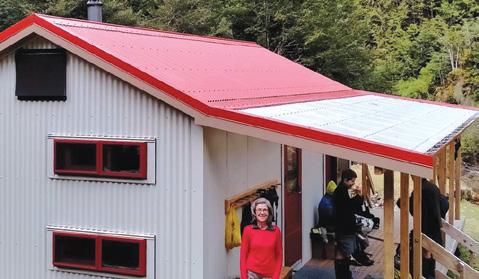
2 minute read
Backcountry workers making a difference
Wanganui Tramping Club member Brigitte Hund at Iron Gate Hut in Ruahine Forest Park. In 2019 the hut was expanded from six to 10 bunks and a large deck added in a partnership between DoC and the Defence Force. Photo / Supplied
With the Conservation Department watching every cent, volunteers are stepping forward to bring new life back to bush and mountain facilities.
Advertisement
Leading the charge is the Backcountry Trust (BCT) which funds and supports volunteers to maintain huts and shared-use tracks.
DoC works in partnership with the BCT to fund volunteer work, acknowledging that this meets its aim to benefit New Zealanders’ recreation.
The trust, which began in 2014, is an independent entity established by the Federated Mountain Clubs, Deerstalkers Association and Trail Fund NZ. Trust volunteers are passionate about outdoor recreation and preserving Aotearoa’s rich inheritance of remote huts and tracks. Their work helps maintain access to our country’s remote places for future generations of backcountry explorers.
The trust’s latest performance report says work done by volunteers and Jobs for Nature contractors in 2021-22 included 47 huts renovated, rebuilt and maintained, around 300km of tracks, one new bridge, around 22,000 hours of work and part funding for two new huts.
There has been a lot of recent activity in the Ruahine and Tararua ranges and upgrading tracks in the Waitotaras — all close to us and therefore familiar to Whanganui trampers and hunters.
The Defence Force has also come to the party. Maropea Forks Hut in the Ruahine was replaced in 2014 in a partnership between the Defence Force and DoC. Army engineers and builders constructed the hut with materials supplied by DoC. And in 2019 the Defence Force and DoC rebuilt Iron Gate Hut, also in the Ruahine, in partnership.
Groups also active in working on huts and tracks include Ruahine Remote Huts, Percolate Southland, Ex-NZFS in the Tararua Ranges, the Kaimai Ridgeway project and many clubs which have taken on DoC huts in need of attention, as well as maintaining their own.
Others operate as independent spontaneous groups on specific projects, according to Geoff Spearpoint writing in Backcountry, the quarterly bulletin of the Federated Mountain Clubs.
He said that was the beauty of the system.
“We have intentionally tried to keep it unfettered to enable people to run projects, within reason, their way. It all comes down to our volunteers, and although we have many, we are always looking for more. Ideally they are self-motivated people who can find a few mates with skills and together manage a project in their local area.”
For those who want to do volunteer work but don’t feel they are capable of hut renovations, there are plenty of tracks in less visited places that could do with maintenance — keeping vegetation trimmed back and the track or route marked where tape or markers and hand tools such as loppers and folding saws can be effective.
Mr Spearpoint notes that volunteers and the BCT do not wish to replace the vital role that DoC also plays in looking after the backcountry network. They see themselves as working with the department, supporting them and helping out, not replacing their efforts.
Meanwhile, the trust is keen to recruit more volunteers for its projects.
Dave Scoullar is a tramper, conservationist and member of the Te Araroa Whanganui Trust. By Dave Scoullar.












